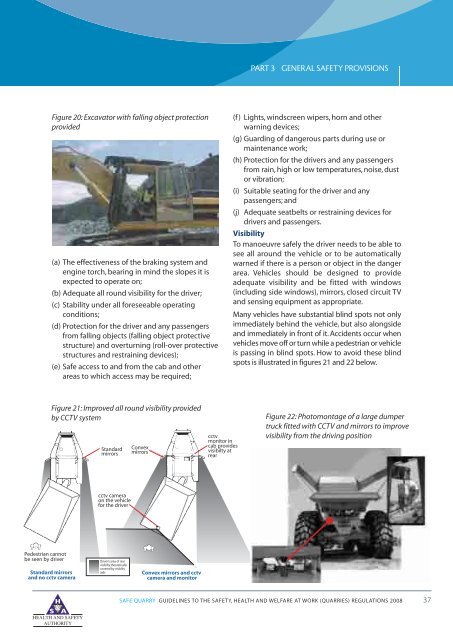Safe Quarry - Health and Safety Authority
Safe Quarry - Health and Safety Authority
Safe Quarry - Health and Safety Authority
You also want an ePaper? Increase the reach of your titles
YUMPU automatically turns print PDFs into web optimized ePapers that Google loves.
PART 3<br />
GENERAL SAFETY PROVISIONS<br />
Figure 20: Excavator with falling object protection<br />
provided<br />
(a) The effectiveness of the braking system <strong>and</strong><br />
engine torch, bearing in mind the slopes it is<br />
expected to operate on;<br />
(b) Adequate all round visibility for the driver;<br />
(c) Stability under all foreseeable operating<br />
conditions;<br />
(d) Protection for the driver <strong>and</strong> any passengers<br />
from falling objects (falling object protective<br />
structure) <strong>and</strong> overturning (roll-over protective<br />
structures <strong>and</strong> restraining devices);<br />
(e) <strong>Safe</strong> access to <strong>and</strong> from the cab <strong>and</strong> other<br />
areas to which access may be required;<br />
(f ) Lights, windscreen wipers, horn <strong>and</strong> other<br />
warning devices;<br />
(g) Guarding of dangerous parts during use or<br />
maintenance work;<br />
(h) Protection for the drivers <strong>and</strong> any passengers<br />
from rain, high or low temperatures, noise, dust<br />
or vibration;<br />
(i) Suitable seating for the driver <strong>and</strong> any<br />
passengers; <strong>and</strong><br />
(j) Adequate seatbelts or restraining devices for<br />
drivers <strong>and</strong> passengers.<br />
Visibility<br />
To manoeuvre safely the driver needs to be able to<br />
see all around the vehicle or to be automatically<br />
warned if there is a person or object in the danger<br />
area. Vehicles should be designed to provide<br />
adequate visibility <strong>and</strong> be fitted with windows<br />
(including side windows), mirrors, closed circuit TV<br />
<strong>and</strong> sensing equipment as appropriate.<br />
Many vehicles have substantial blind spots not only<br />
immediately behind the vehicle, but also alongside<br />
<strong>and</strong> immediately in front of it. Accidents occur when<br />
vehicles move off or turn while a pedestrian or vehicle<br />
is passing in blind spots. How to avoid these blind<br />
spots is illustrated in figures 21 <strong>and</strong> 22 below.<br />
Figure 21: Improved all round visibility provided<br />
by CCTV system<br />
St<strong>and</strong>ard<br />
mirrors<br />
Convex<br />
mirrors<br />
cctv<br />
monitor in<br />
cab provides<br />
visibilty at<br />
rear<br />
Figure 22: Photomontage of a large dumper<br />
truck fitted with CCTV <strong>and</strong> mirrors to improve<br />
visibility from the driving position<br />
cctv camera<br />
on the vehicle<br />
for the driver<br />
Pedestrian cannot<br />
be seen by driver<br />
St<strong>and</strong>ard mirrors<br />
<strong>and</strong> no cctv camera<br />
Driver’s area of rear<br />
visibilty theoretically<br />
covered by visiblity<br />
aids<br />
Pedestrian visible<br />
in cctv monitor<br />
Convex mirrors <strong>and</strong> cctv<br />
camera <strong>and</strong> monitor<br />
SAFE QUARRY GUIDELINES TO THE SAFETY, HEALTH AND WELFARE AT WORK (QUARRIES) REGULATIONS 2008 37
















